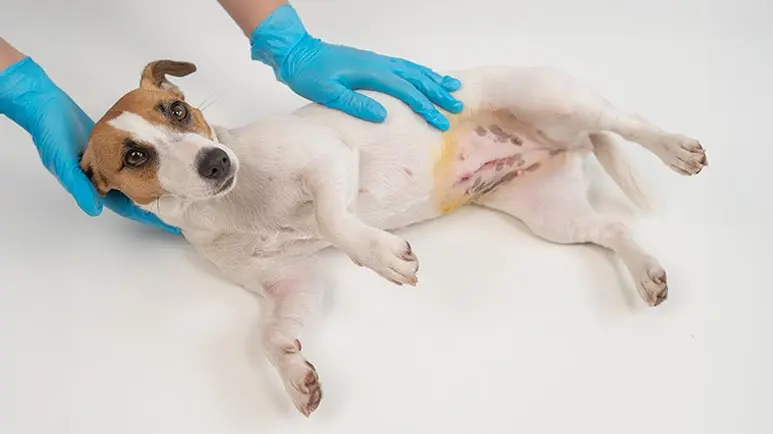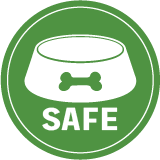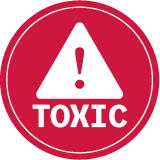What's Causing Your Dog's Swollen Belly?
A swollen belly in dogs can stem from minor issues to serious emergencies such as bloat. Early identification of the cause is crucial for timely and appropriate care.

STORY AT-A-GLANCE
- A swollen belly in dogs can indicate various health conditions, ranging from mild issues like obesity to severe emergencies like bloat. Timely recognition of the cause is crucial
- Certain breeds are more prone to bloating, which also causes pacing, restlessness, drooling, dry heaving, rapid heartbeat, shortness of breath and signs of pain; this condition requires immediate medical attention
- Other factors that can cause abdominal swelling in dogs include parasites, pregnancy, organ enlargement, tumors, hormonal disorders and fluid accumulation, each presenting unique accompanying symptoms
- If your dog’s belly is swollen, carefully observe them for other symptoms, avoid pressing the area, and promptly schedule a veterinary visit to ensure their safety and well-being
- Maintaining your dog's health through a balanced diet, regular exercise, smaller meal portions and consistent veterinary check-ups can help reduce the risk of abdominal problems
A swollen belly in your dog is hard to miss, and it’s often a sign that something isn’t right. Whether it appears suddenly or develops over time, it’s important to take it seriously. While some causes are harmless, others can quickly become life-threatening if left untreated. Recognizing when a swollen abdomen requires urgent care and understanding potential causes will better prepare you to protect your dog’s health and well-being.
10 Common Causes of Stomach Swelling and Other Signs to Watch Out For
A distended abdomen is not a condition itself but a symptom of various health conditions, ranging from mild concerns to serious, life-threatening emergencies. Paying attention to accompanying signs will help you identify the severity and get your dog the help they need. Below are the most common causes of abdominal swelling in dogs and what to look out for:1,2
- Bloat (gastric dilatation-volvulus or GDV) — Bloat is a severe, life-threatening cause of swollen abdomens in dogs. It occurs when the stomach fills with gas, food or fluid and twists, cutting off blood flow and trapping the contents. Without immediate intervention, this condition can cause shock, organ damage and death within hours.
Large, deep-chested breeds like Great Danes, Boxers and German Shepherds are most prone to bloat, especially after consuming a large meal or drinking excessive water quickly. The other symptoms of GDV include:3- Restlessness, pacing and inability to lie down comfortably
- Excessive drooling or foamy saliva
- Attempts to vomit without producing anything (dry heaving)
- A visibly distended or hard abdomen
- Rapid breathing, weakness or sudden collapse
- Ascites (fluid accumulation in the abdomen) — Ascites is the abnormal buildup of fluid in your dog’s abdominal cavity. It’s often a symptom of another underlying issue, such as heart failure, liver disease, kidney dysfunction or certain cancers. Fluid buildup puts pressure on surrounding organs, making it difficult for your dog to breathe or move comfortably. Other signs that ascites may be the cause of stomach swelling include:4
- Labored breathing, especially when lying down
- Lethargy and reluctance to engage in activity
- Reduced appetite or vomiting in some cases
- Obesity — Excess weight, typically caused by overeating, poor diet or lack of exercise is a common but often overlooked cause of swollen belly in dogs. While it may seem harmless, obesity can lead to serious health problems such as arthritis, diabetes, heart disease and a reduced lifespan. Signs of obesity include gradual weight gain, a lack of a visible waistline, difficulty with movement and shortness of breath even during light activity.5
- Pregnancy and false pregnancy — In unspayed female dogs, a swollen belly may sometimes be due to pregnancy, which lasts about 63 days. As gestation progresses, the abdomen becomes noticeably larger, accompanied by other physical and behavioral changes.6
However, hormonal imbalances can also trigger false pregnancy, a condition where a dog’s body mimics the signs of pregnancy even when no puppies are present.7 Other signs that could indicate pregnancy or false pregnancy include:8- Enlarged, darkened nipples or signs of milk production
- Increased appetite or occasional lethargy
- Nesting behaviors, like gathering blankets or toys
- Clinginess, restlessness or changes in temperament
- Internal parasites — Worm infestations are a common cause of swollen bellies, particularly in puppies. Roundworms, hookworms and tapeworms can take hold in a dog’s digestive system, feeding off nutrients and leading to malnutrition. Puppies are often infected through their mother or contaminated environments, but adult dogs are also at risk.9 Other symptoms of a parasite infestation include:
- A pot-bellied appearance, especially in puppies
- Vomiting or diarrhea, sometimes with visible worms
- Weight loss despite a healthy or increased appetite
- Dull, patchy or poor coat quality
- Organ enlargement — Enlarged organs, such as the liver or spleen, may cause abdominal swelling due to infections, cancer or immune-mediated diseases. Other symptoms that often accompany organ enlargement include weakness or fatigue, loss of appetite and sensitivity when the abdomen is touched. Vets typically perform imaging tests to confirm this diagnosis.10
- Cushing’s disease — Cushing’s disease results from an overproduction of cortisol, a stress hormone, usually due to issues with the adrenal or pituitary glands. It commonly affects middle-aged and older dogs and often develops slowly, making early signs easy to miss.11
Cushing’s disease causes a pot-bellied appearance due to fat redistribution and weak abdominal muscles. Its other symptoms include increased thirst and urination, excessive panting even when at rest, muscle weakness and thinning hair.12 - Peritonitis — This condition is caused by the inflammation of the peritoneum, the thin membrane lining the abdominal cavity. It occurs when bacteria, bile or other irritants leak into the abdomen due to trauma, a ruptured organ (such as the intestines, bladder or gallbladder) or complications from conditions like ulcers or infections.13 Peritonitis is a medical emergency and requires immediate veterinary care. Other symptoms include:14
- Severe lethargy and weakness
- Loss of appetite or refusal to eat
- Vomiting and diarrhea
- Fever or low body temperature
- Rapid breathing, panting or signs of distress
- Tumors and masses — Abdominal growths, whether benign or cancerous, can cause swelling over time. These tumors can develop in the organs or tissues within the abdomen, pressing on nearby structures and causing discomfort. Other warning signs of abdominal tumors include loss of appetite, vomiting, lethargy or reduced activity, and signs of pain or discomfort when touched.15
- Trauma or injury — If your dog has recently had a fall, accident or other trauma, abdominal swelling could be due to internal bleeding. This is a serious emergency that requires immediate veterinary attention. Other signs of internal bleeding may include pale gums, rapid breathing, fast heart rate, weakness and sudden collapse. If there’s any chance your dog has been injured, it’s best to be safe and get them checked out right away.16
Steps to Take if Your Dog Has a Swollen Belly
If you notice your dog’s belly is swollen, taking the right steps promptly can significantly improve treatment outcomes and save your dog's life. Here’s what you should do:17
- Monitor your dog closely — Note when the swelling started, whether it appeared suddenly or gradually, and any other symptoms. These details will help your veterinarian assess the severity and cause.
- Treat sudden, severe swelling as an emergency — If the swelling occurs suddenly, particularly if your dog exhibits symptoms of GDV or internal bleeding, call your vet or the nearest animal hospital and transport your dog immediately. Conditions like these can rapidly become fatal without prompt intervention.
- Avoid pressing on the abdomen — If your dog’s belly looks distended, avoid pressing or poking it, as this could worsen discomfort or pain. Dogs experiencing abdominal swelling may already be in distress, and additional pressure could exacerbate their condition.
- Schedule a vet visit without delay — Regardless of whether the swelling seems mild or severe, veterinary evaluation is crucial. Your veterinarian will perform diagnostic tests, including X-rays, blood work, ultrasounds or fluid analysis, to pinpoint the cause and recommend treatment.
Depending on the diagnosis, your dog may require treatments ranging from dietary changes and parasite control to medications, fluid drainage or even emergency surgery.
Proactive Steps to Protect Your Dog from Abdominal Swelling
While not all causes of a swollen belly can be prevented, there are steps you can take to reduce the risks:
- Feed a balanced, species-appropriate fresh food diet — A proper diet is the foundation of your dog’s health. Focus on a nutritionally balanced, meat-based fresh food diet while avoiding grains, refined starches and high-glycemic ingredients like corn, wheat, rice and starchy flours, which can disrupt your pet’s digestion.
Choose foods free from preservatives, artificial dyes, flavorings, emulsifiers, citric acid and genetically modified (GM) ingredients. For treats, opt for high-quality, limited-ingredient meat-based options or fresh food alternatives. Be mindful of portion sizes and avoid overfeeding or offering excessive treats, as this can contribute to weight gain and obesity. - Feed smaller, more frequent meals — If your dog is prone to bloating or eats quickly, feed multiple smaller meals throughout the day instead of one large meal. This approach eases digestion and reduces the risk of abdominal stress. If your dog eats too quickly, consider using slow-feeder bowls, lick mats or spread their food across a baking sheet to slow their eating and reduce the risk of bloating.
- Stick to a regular exercise routine — Whether it’s daily walks, active play sessions or mental stimulation through training, keeping your dog active helps prevent obesity and improves their cardiovascular and digestive health.
- Schedule routine vet check-ups to catch potential problems early before they escalate. Schedule regular wellness exams, ideally twice a year for older dogs or annually for younger, healthy pets.
During these visits, your vet can monitor your dog’s weight, check for internal issues and perform blood work or imaging, if needed. Early detection of conditions like organ disease, parasites or hormonal imbalances can significantly improve outcomes. - Keep up with parasite prevention — Regular deworming and routine fecal exams are essential to keep your dog parasite-free. However, accurate diagnosis is essential — your veterinarian will need to identify the specific type of worm in your dog’s intestinal tract, as no single dewormer eliminates all parasites.
After treatment, support your dog’s gut health with probiotic-rich foods or supplements to restore beneficial bacteria. Make sure you maintain a clean living environment and keep your dog away from contaminated areas to reduce their risk of reinfection.
Sources and References
- 1,5,6,13,15,16,17 Great Pet Care, October 25, 2024
- 2 Highland Veterinary Clinic, What Causes a Dog's Stomach to Swell Up?
- 3 PetMD, February 28, 2024
- 4 MSD Veterinary Manual, Ascites in Small Animals
- 7 VCA Animal Hospitals, False Pregnancy or Pseudopregnancy in Dogs
- 8 AKC, January 7, 2025
- 9 MSD Veterinary Manual, Gastrointestinal Parasites of Dogs
- 10 VCA Animal Hospitals, Testing for Abdominal Enlargement in Dogs
- 11 FDA, Treating Cushing's Disease in Dogs
- 12 VCA Animal Hospitals, Cushing's Disease in Dogs
- 14 MSD Veterinary Manual, Peritonitis in Dogs











